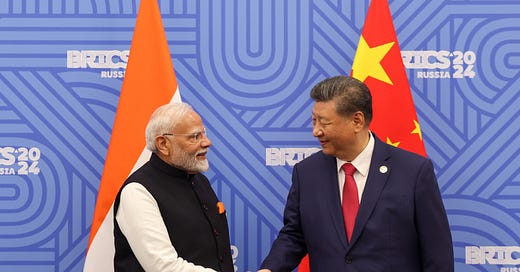India-China Border Thaw: A Temporary Resolution Amidst Broader Geopolitical Dynamics
Ongoing diplomatic engagements, supported by consistent efforts to reduce military presence along the LAC, will be essential in ensuring that this agreement serves as more than a temporary reprieve.
Background and Context
The recent agreement between India and China to resume patrolling along the Line of Actual Control (LAC) marks a crucial step in de-escalating the tensions that arose from the 2020 military standoff. The deadly clash in the Galwan Valley, which became one of the most severe confrontations between the two nations in decades, significantly strained bilateral relations. This agreement arrives at a pivotal moment, coinciding with the BRICS summit in Kazan, Russia, where Indian Prime Minister Narendra Modi and Chinese President Xi Jinping had an opportunity for diplomatic engagement. Russian President Vladimir Putin, serving as a gracious host, subtly facilitated this interaction, further underscoring the role of multilateral platforms in managing such regional disputes.
Key Elements of the Agreement
Central to the agreement is the restoration of pre-2020 patrolling protocols along the LAC, particularly in eastern Ladakh. Disengagement from friction points like Demchok and Depsang, long-standing areas of contention, forms the core of the deal. The agreement emerged after extensive diplomatic negotiations, facilitated through established mechanisms like the Working Mechanism for Consultation and Coordination (WMCC) and Corps Commander-level talks. These channels have been pivotal in maintaining a dialogue between both sides throughout the ongoing crisis.
Diplomatic and Strategic Implications
While the resumption of patrolling signals a positive move, there is considerable caution regarding China's long-term intentions. The restoration of patrolling rights is seen as a preliminary step towards a broader process that would ideally involve disengagement, de-escalation, and the eventual de-induction of forces from the border region. However, significant challenges remain, particularly as China has constructed permanent infrastructure along contested areas, making a full return to the status quo ante difficult to achieve.
The agreement also underscores the complexity of India-China relations. Despite their geopolitical rivalry, the two nations maintain substantial economic ties, with China ranking among India's top trading partners. As border tensions ease, there may be an opportunity to improve bilateral relations, both politically and economically, possibly paving the way for more comprehensive diplomatic engagement.
The Role of Trade and Business Pressure
Despite persistent geopolitical friction, trade between India and China has grown, reflecting the intricate economic interdependence between the two countries. By 2024, bilateral trade had reached an impressive $118.4 billion, with India's dependency on Chinese imports for sectors like telecommunications and pharmaceuticals driving much of this growth.
The Indian business community has been vocal in pushing for a reduction in trade restrictions imposed after the 2020 conflict. Many businesses, concerned about economic slowdown and technological access, have lobbied for easing curbs on Chinese investments and visas. This economic pressure undoubtedly played a role in the diplomatic efforts that culminated in the current disengagement agreement.
The Influence of BRICS and Russia
The timing of the border agreement coinciding with the BRICS summit adds considerable strategic significance. The BRICS platform, originally comprising Brazil, Russia, India, China, and South Africa, and now expanded with five additional member nations, serves as a vital forum for emerging economies to coordinate on global economic and geopolitical issues. By resolving their border dispute, even temporarily, India and China have delivered a powerful signal to the international community, particularly Western powers, highlighting their capacity to manage bilateral disputes independently and reinforcing the shift towards a multipolar world order.
Russia's role as the host of the summit further emphasises its influence within the group and its vested interest in fostering cooperation among member states. As BRICS expands its membership, its ability to advocate for the interests of developing economies will be further strengthened.
Challenges and Future Prospects
The resolution of immediate border tensions does not eliminate the deeper, more entrenched challenges facing India-China relations. Trust between the two militaries has been severely undermined by the prolonged standoff, and rebuilding this trust will be crucial to maintaining peace. Furthermore, the agreement does not fully address the broader and more complex border dispute between the two nations, leaving room for future conflicts if a more comprehensive solution is not sought.
Ongoing diplomatic engagements, supported by consistent efforts to reduce military presence and infrastructure along the LAC, will be essential in ensuring that this agreement serves as more than a temporary reprieve. Both nations will need to commit to long-term confidence-building measures to avoid further escalations.
Summing Up and Looking Forward
The India-China border agreement marks a cautious yet significant step forward. Indian domestic media, reflecting widespread scepticism towards China, have largely avoided overt celebration, underscoring concerns over Beijing's trustworthiness. This sentiment has led Indian politicians to adopt a reserved tone when discussing the prospects of improved relations. Nonetheless, the BRICS summit provided an ideal platform for announcing this détente, highlighting the increasing relevance of multilateral forums in resolving regional tensions. Prime Minister Narendra Modi acknowledged the moment diplomatically, tweeting: “Met President Xi Jinping on the sidelines of the Kazan BRICS Summit. India-China relations are important for the people of our countries, and for regional and global peace and stability. Mutual trust, mutual respect, and mutual sensitivity will guide bilateral relations.” This statement encapsulates India’s cautious approach while emphasising the significance of rebuilding trust in shaping the future trajectory of bilateral ties.
While the agreement addresses some immediate tensions along the LAC, its long-term success depends on sustained diplomatic engagement, confidence-building, and careful navigation of the complex geopolitical landscape. As India and China continue to balance their often divergent interests, the significance of economic ties and trade in shaping future relations remains critical. Though limited in scope, this agreement signals the possibility of broader cooperation amidst evolving global dynamics.






……rightly concluded that the scope is really limited, and further hope of broader cooperation amidst evolving global dynamics, is quite dim. For both countries, it is almost gimmick to show up the faces as being joint partners to draw attention from superpower USA, nothing more …..